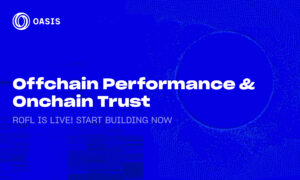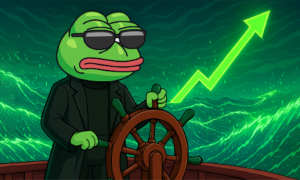There has been massive innovations and developments in the blockchain space since its inception with the technology fostering enormous aptitude stretching from finance, medicine, AI, and recently, the gaming space via the development of non-fungible tokens (NFTs). The growth of NFTs over the past two or three years has seen the blockchain gaming space explode into a multi-billion industry, and as Sagi Maman, Founder of Xternity, a new scalable open development platform, the space is primed for even more success.
With the industry primed to reach nearly $3 billion by 2028, we caught up with Mr Maman to discuss the potential the industry has, how developers can create greater value in the space, and the potential innovations the blockchain gaming industry could bring to traditional gaming. Finally, with Xternity launching its open beta platform, Maman explains how the platform will help in bettering the development of these games and scaling them to the global mass market.
Hello Sagi, welcome to Techbullion. Could you start by briefly telling us about yourself and the journey that Xternity has taken to this point?
Hi! My name is Sagi, I’m from Tel-Aviv, Israel. I co-founded Xternity together with my best friend Shahar, who is the CTO of the company. Before Xternity, I was Head of Monetization at Playtika. I led monetization and product monetization teams. After meeting so many great teams, products and games that just found it hard to grow in such a competitive environment, we came up with the vision to support game developers with the ultimate umbrella to monetize their game, not only by Ads. Web3 games concept can be a great opportunity since the economy is open, unlike web2, and makes it possible to implement a broad solution.
Very soon after we started working on Xternity, we learnt two critical lessons. First, the current models (P2E, play to own, win to own, etc.) are not sustainable and need to be redefined. Second, the blockchain games’ user experience won’t allow adoption of mass players. After mapping the main constraints we started building our own project as a sandbox and then with our design partners we built a seamless player experience and reduced the time for game developers to build a layer on web3.
Congratulations on the recent launch of the Xternity open beta platform. What exciting features should gamers be on the lookout for?
Thanks, we actually built a lot of features but I don’t think that building features is the goal. The focus is to figure out which use cases are the most relevant for brands and business in general and more specifically for games. Under this mindset, we didn’t think only about what is needed for the developer but more importantly which products will be embraced by the community (users) and will keep them more engaged.
One example is the Loyalty program. To support a brand who is going to implement our Loyalty program we also provide an embedded wallet, social login, auto minting, FIAT payment, customized user zone, economy management system and more. But the bottom line is which benefits the user will get from a Web3 Loyalty that he couldn’t get in web2. The best test is to describe this product without mentioning Web3 or Blockchain or NFT for the end user.
An interesting fact is that Xternity builds no-code solutions that help game developers boost players’ engagement in the Web 3 space. Briefly explain to our readers what “no-code” solutions mean.
Web3 is still at the very beginning of the adoption phase. There are not enough proven use cases and the motivation of brands and games to adopt Web3 is in most cases to explore the potential in this new space before allocating development resources, especially Blockchain developers which are usually not part of their teams.
We also suggest our partners to gradually adopt the concept and start with small steps that can be executed with operations or marketing teams. For this reason, we built a console that helps them build a full blown experience without writing one line of code.
The team also raised $4.5 million in a funding round supported by notable investors. including Jibe Ventures, Flori Ventures, Secret Chords, Vgames, and NFX. How do you plan to spend the funds to boost Web 3 gaming and engagement on your platform?
As I mentioned before, we believe that the key for web3 to be successful is to define and develop the right business model that can leverage the transition from personal economy to community economy. Currently, the majority of these communities are made up of GenZ users, but it is spreading to more audiences and more industries. The first step was to build an infrastructure that will fulfill our 3 principles: Simple, Safe, Scalable.
After achieving this goal, we’re going to release new products and economy models to optimize the user experience.
Following the launch of the open beta, what is in the pipeline for Xternity in terms of expansion and overall growth of the company?
Initially, we’re going to open our beta to more developers and we also have a plan to release a free version to help other builders. In addition, we’re working with our gaming partners to build and optimize new products. At the first stage, the enhancements are done within the boundries of each game. As we progress, we will release more abilities for communities to collaborate.
The explosive growth of NFT gaming has been nothing short of incredible in the past few years, with the market currently valued at $770 million. A recent report showed that the market could grow into a $2.8 billion market by 2028 predicting a mass adoption for the industry. What are Xternity’s long-term goals towards boosting the adoption of Web 3 games?
We think a little bit differently. Even though P2E and NFTs push the adoption, and we do appreciate this, it was done with the wrong best practices based on unsustainable models. By the way, this is why we didn’t use a token on our platform. In the long term, web3 will allow game developers to bring more value to their players by empowering their community and unleash the potential of a network effect between games without a centralized middle-player. Since it’s an evolution, in the foreseeable future, I believe that web3 will be adopted as a meta content layer with minor impact on the core game economy.
Despite the growth, the NFT gaming industry is still in its formative years hence projects face challenges and massive competition from console gaming. What should startups in the Web 3 gaming industry do to help them compete favourably with the traditional gaming industry?
Traditional companies move slowly. It’s not about the people, they just have more to lose. I’ve been there. However, as a startup, we can and must be more bold and I would even say foolish. The second important thing is to focus on what consumers want. Partnerships among web3 startups is great and necessary to compete with the traditional giants companies, but we shouldn’t be confused, the only North Star we have is the player.
Finally, NFT gaming appeals to millennials and Gen Z more than other generations, as many studies have shown. How do you plan to boost these younger generations’ engagement in the coming 5-10 years?
I think this is the most important question. We added to our team GenZ advisors and we work with them a lot. Actually, they are a major part of our design thinking process. As for now, I believe that they are going to boost their own engagement. We just need to give them the right environment and platform. Brands who won’t take them into consideration will find it very difficult to grow in the next 5-10 years. They are much smarter, they are well aware of the power they have as a group and they already proved it in so many cases. From short squeezing in Reddit groups to building $200B foundation like Ethereum,
our solutions will allow games to empower GenZ communities to impact the brand and get value benefits (not necessarily monetary).
Sagi Maman is a former officer of the Israeli Air Force with an experience of 12 years in service. He joined Playtika, a pioneer in the games industry as Team leader on the popular game, House of Fun and Caeser Slots before becoming the Director of Monetization and Product Marketing. In 2022, he the blockcfounded his first blockchain game, Xternity Games with a goal to onboarding gamers to web3.



































